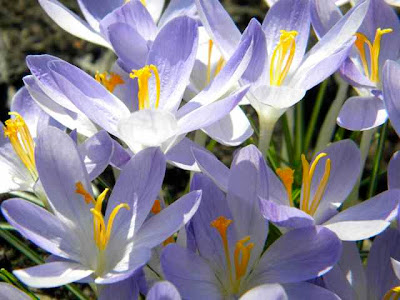"The secret to attracting birds, butterflies ad other wonderful wildlife to your backyard lies in restoring their natural habitat."
David Mizeyewski, National Wildlife Federation
At the start of this new gardening year, I am planning to do more to attract desirable wildlife to my garden. In the Poconos, like most places on Earth, a great deal of natural habitat has disappeared due to the rapid growth of residential areas and the way in which we maintain our homes. As a child in England I loved to gather bluebells from the woods, and catch tadpoles to watch as they changed into frogs. I want my grandchildren to have similar experiences. Loss of habitat is the number one threat to wildlife today!! The National Wildlife Federation has identified how we can provide for the needs and conditions that enable wildlife to survive and thrive.
I am proud to say my garden is a certified Wildlife Habitat, as shown by the sign. I try to follow the National Wildlife Federation guidelines for a quality habitat by providing food, water, cover, and places to raise their young.
1. FOOD
Seeds, berries, nectar, nuts and fruit from plants is the best food source.
Native plants are most desirable. I have many native plants in my garden:
My grandson placed a stone turtle under the turtlehead.
The lungwort is just coming into bloom.
Feeders supplement the food I provide through my plantings. My handsome husband (HH) puts out two types of seed feeders that are pretty much squirrel proof.
HH provides suet as a high energy food for the winter.
My Mum has a platform feeder for birds that normally forage on the ground. She particularly likes to attract the mourning doves. She obviously doesn't have a squirrel problem at her home in England
2. WATER
If birds can't bathe, their feathers become dirty making flying difficult. I would love a pond like this one I photographed on a garden tour. It is on our to-do list, but cost is a problem.
In the meantime, we provide bird baths and fountains. In the winter the bluebirds love the heated water dish.
3. COVER
Wildlife needs shelter from the weather and from predators. Here at the farm we are fortunate to have wooded areas, thickets, and bramble patches. We leave dead trees standing where possible. When the branches fall, the holes provide nesting places as well as cover. Woody debris is an important source of cover for insects and invertebrates, and small mammals.
Standing dead trees are called snags.
You can create a log and brush pile to form a "wildlife hotel". This turtle lives under our brush pile.
4. PLACES TO RAISE THEIR YOUNG
We attached six or more nesting boxes to this fence. The brambles and wild area behind the fence provide natural nesting places.
Many of the places that provide cover for wildlife are also the best places for raising their young.
A chickadee sheltered in the "church" during our last snowfall. A thrush nested in there last spring.
Milkweed is the host plant for the Monarch butterfly. We don't have any on our property yet, but HH gathered milkweed seeds last fall and we plan to plant them soon.
Finally, if we want birds, bees, and butterflies in our gardens, it is necessary to practice SUSTAINABLE GARDENING. I addressed this in a recent post called, What is Sustainable Gardening?
Today, I looked out and saw the goldfinches have got their golden feathers. They stayed around all winter in their drab, olive coats. Now the "gold" has been put back into "goldfinch" I feel spring has truly arrived!
The rewards of gardening for wildlife are many. For me it added beauty to my garden, improved air, water, and soil quality, restored habitats, and best of all it is FUN!! I encourage you to click on the Wildlife Habitat sign in my sidebar, and learn how YOUR backyard can become a certified Wildlife Habitat.
~~
I love reading your comments. I hope you leave one so I’ll know you visited!































